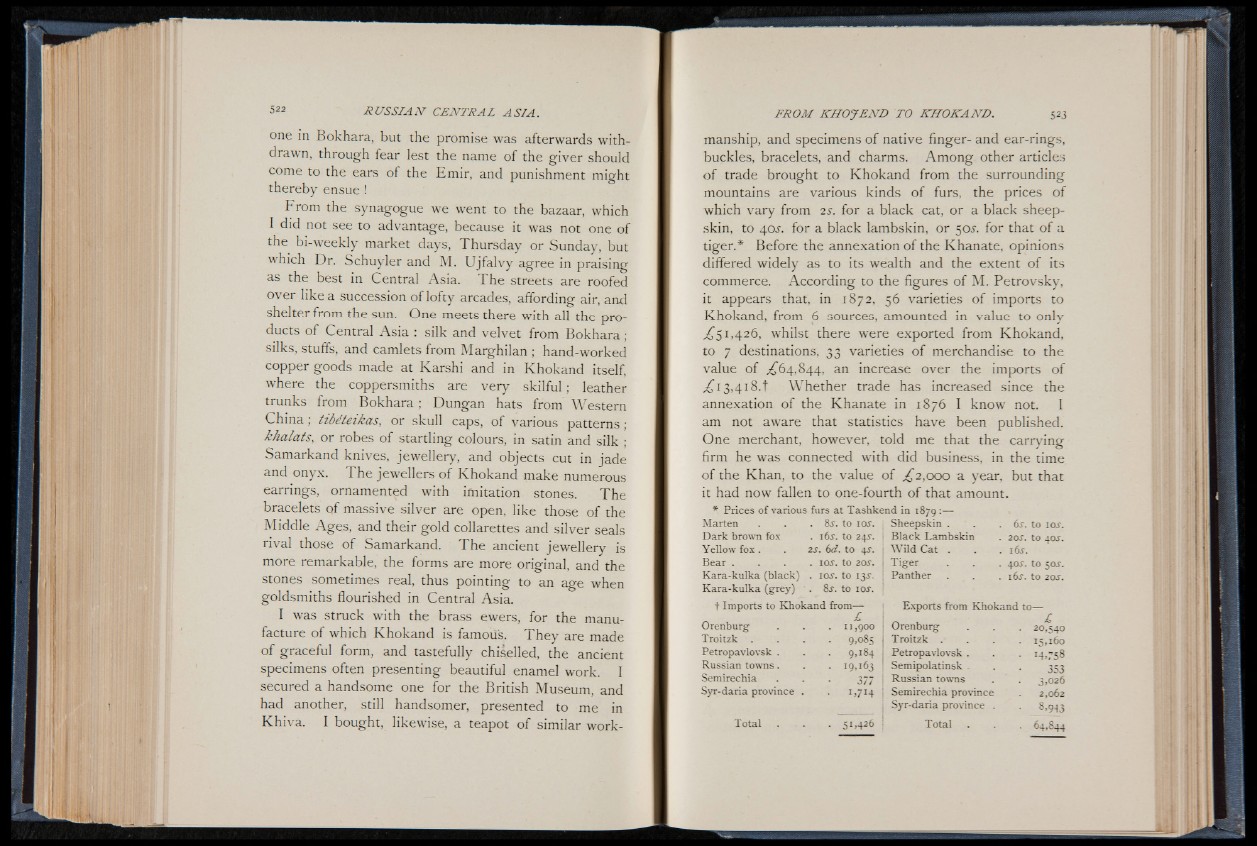
one in Bokhara, but the promise was afterwards withdrawn,
through fear lest the name of the giver should
come to the ears of the Emir, and punishment might
thereby ensue !
From the synagogue we went to the bazaar, which
I did not see to advantage, because it was not one of
the bi-weekly market days, Thursday or Sunday, but
which Dr. Schuyler and M. Ujfalvy agree in praising
as the best in Central Asia. The streets are roofed
over like a succession of lofty arcades, affording air, and
shelter from the sun. One meets there with all the products
of Central Asia : silk and velvet from Bokhara;
silks, stuffs, and camlets from Marghilan ; hand-worked
copper goods made at Karshi and in Khokand itself,
where the coppersmiths are very skilful; leather
trunks from Bokhara; Dungan hats from Western
China , tibdteikas, or skull caps, of various patterns ;
khalats, or robes of startling colours, in satin and silk ;
Samarkand knives, jewellery, and objects cut in jade
and onyx. The jewellers of Khokand make numerous
earrings, ornamented with imitation stones. The
bracelets of massive silver are open, like those of the
Middle Ages, and their gold collarettes and silver seals
rival those of Samarkand. The ancient jewellery is
more remarkable, the forms are more original, and the
stones sometimes real, thus pointing to an age when
goldsmiths flourished in Central Asia.
I was struck with the brass ewers, for the manufacture
of which Khokand is famous. They are made
of graceful form, and tastefully chiselled, the ancient
specimens often presenting beautiful enamel work. I
secured a handsome one for the British Museum, and
had another, still handsomer, presented to me in
Khiva. I bought, likewise, a teapot o f similar workmanship,
and specimens of native finger- and ear-rings,
buckles, bracelets, and charms. Among other articles
o f trade brought to Khokand from the surrounding
mountains are various kinds of furs, the prices of
which vary from 2s. for a black cat, or a black sheepskin,
to 40^. for a black lambskin, or $os. for that of a
tiger.* Before the annexation of the Khanate, opinions
differed widely as to its wealth and the extent of its
commerce. According to the figures of M. Petrovsky,
it appears that, in 1872, 56 varieties of imports to
Khokand, from 6 sources, amounted in value to only
,¿51,426, whilst there were exported from Khokand,
to 7 destinations, 33 varieties of merchandise to the
value of ,¿64,844, an increase over the imports of
.¿13,418.1 Whether trade has increased since the
annexation of the Khanate in 1876 I know not. I
am not aware that statistics have been published.
One merchant, however, told me that the carrying
firm he was connected with did business, in the time
of the Khan, to the value of £2,000 a year, but that
it had now fallen to one-fourth of that amount.
* Prices of various furs at Tashkend in 1879 :—
Marten . 8r. to 1 os. Sheepskin . . 6.s . to ior.
Dark brown fox . 16s . to 24s . Black Lambskin . 2or. to aor.
Yellow fox . 2s . 6d . to 4J. W ild Ca t . . 16s .
Bear . . IQS'. tO 20X. Tige r . 4or. to sor.
Kara-kulka (black)
. io r. to 13X.
Panther . ior. to 2or.
Kara-kulka (grey)
. 8r. to ior.
t Imports to Khokand from—
£
Exports from Khokand to—
S
Orenburg . 11,900 Orenburg . 20,540
Troitzk . - 9.085 Troitzk . . 15,160
Petropavlovsk . - 9.^4 Petropavlovsk . • H.758
Russian towns. • i 9=l63 Semipolatinsk . 353
Semirechia 3/7 Russian towns - 3.026
Syr-daria province • *,714 Semirechia province 2,062
Syr-daria province . • 8,943
Total - 51.426 Total - 64.844